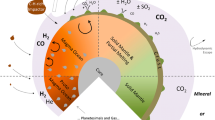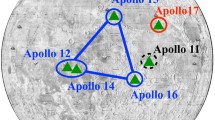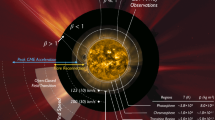Abstract
The Time History of Events and Macroscale Interactions during Substorms (THEMIS) mission is the fifth NASA Medium-class Explorer (MIDEX), launched on February 17, 2007 to determine the trigger and large-scale evolution of substorms. The mission employs five identical micro-satellites (hereafter termed “probes”) which line up along the Earth’s magnetotail to track the motion of particles, plasma and waves from one point to another and for the first time resolve space–time ambiguities in key regions of the magnetosphere on a global scale. The probes are equipped with comprehensive in-situ particles and fields instruments that measure the thermal and super-thermal ions and electrons, and electromagnetic fields from DC to beyond the electron cyclotron frequency in the regions of interest. The primary goal of THEMIS, which drove the mission design, is to elucidate which magnetotail process is responsible for substorm onset at the region where substorm auroras map (∼10 RE): (i) a local disruption of the plasma sheet current (current disruption) or (ii) the interaction of the current sheet with the rapid influx of plasma emanating from reconnection at ∼25 RE. However, the probes also traverse the radiation belts and the dayside magnetosphere, allowing THEMIS to address additional baseline objectives, namely: how the radiation belts are energized on time scales of 2–4 hours during the recovery phase of storms, and how the pristine solar wind’s interaction with upstream beams, waves and the bow shock affects Sun–Earth coupling. THEMIS’s open data policy, platform-independent dataset, open-source analysis software, automated plotting and dissemination of data within hours of receipt, dedicated ground-based observatory network and strong links to ancillary space-based and ground-based programs. promote a grass-roots integration of relevant NASA, NSF and international assets in the context of an international Heliophysics Observatory over the next decade. The mission has demonstrated spacecraft and mission design strategies ideal for Constellation-class missions and its science is complementary to Cluster and MMS. THEMIS, the first NASA micro-satellite constellation, is a technological pathfinder for future Sun-Earth Connections missions and a stepping stone towards understanding Space Weather.
Similar content being viewed by others
References
A.T. Aikio et al., Characteristics of pseudobreakups and substorms observed in the ionosphere, at the geosynchronous orbit, and in the midtail. J. Geophys. Res. 104, 12263 (1999)
S.-I. Akasofu, Physics of Magnetospheric Substorms (Reidel, Dordrecht, 1976)
V. Angelopoulos et al., Statistical characteristics of bursty bulk flow events. J. Geophys. Res. 99, 21257 (1994)
V. Angelopoulos et al., Magnetotail flow bursts: association to global magnetospheric circulation, relationship to ionospheric activity and direct evidence for localization. Geophys. Res. Lett. 24, 2271 (1997a)
V. Angelopoulos et al., Multipoint analysis of a bursty bulk flow event on April 11, 1985. J. Geophys. Res. 101, 4967 (1997b); also see correction: J. Geophys. Res., 102, 211 (1997b)
V. Angelopoulos et al., On the relationship between bursty flows, current disruption and substorms. Geophys. Res. Lett. 26, 2841 (1999)
V. Angelopoulos et al., Plasma sheet electromagnetic power generation and its dissipation along auroral field lines, J. Geophys. Res. (2001, in press)
G. Atkinson, The current system of geomagnetic bays. J. Geophys. Res. 23, 6063 (1967)
U. Auster et al., Space Sci. Rev. (2008, this issue)
D.N. Baker et al., Neural line model of substorms: Past results and present view. J. Geophys. Res. 101, 12975 (1996)
M. Bester et al., Space Sci. Rev. (2008, this issue)
W. Baumjohann et al., Average plasma properties in the central plasma sheet. J. Geophys. Res. 94, 6597 (1989)
J. Birn et al., Flow braking and the substorm current wedge. J. Geophys. Res. 104, 19895 (1999)
Bonnell et al., Space Sci. Rev. (2008, this issue)
J.E. Borovsky et al., The occurrence rate of magnetospheric-substorm onsets: random and periodic substorms. J. Geophys. Res. 98, 3807 (1993)
C.W. Carlson et al., Space Sci. Rev. (2008, this issue)
M.R. Collier et al., Timing accuracy for the simple planar propagation of magnetic field structures in the solar wind. Geophys. Res. Lett. 25, 2509 (1998)
N.U. Crooker et al., Factors controlling degree of correlation between ISEE 1 and ISEE 3 interplanetary magnetic field measurements. J. Geophys. Res. 87, 2224 (1982)
C.M. Cully et al., Space Sci. Rev. (2008, this issue)
I.A. Daglis et al., “Fine structure” of the storm-substorm relationship: ion injections during Dst decrease. Adv. Space Res. 25, 2369 (2000)
R.D. Elphinstone et al., Observations in the vicinity of substorm onset: implications for the substorm process. J. Geophys. Res. 100, 7937 (1995)
D.H. Fairfield et al., Upstream pressure variations associated with the bow shock and their effects on the magnetosphere. J. Geophys. Res. 95, 3773–3786 (1990)
D.H. Fairfield et al., Advances in magnetospheric storm and substorm research, 1989–1991. J. Geophys. Res. 97(A7), 10865–10874 (1992)
D.H. Fairfield et al., Geotail abservations of substorm onset in the inner magnetotail. J. Geophys. Res. 103 (1998)
C. Farrugia et al., Viscous-type processes in the solar wind–magnetosphere interaction. Space. Sci. Rev. 95(1/2), 443–456 (2001)
L.A. Frank, J.B. Sigwarth, Findings concerning the positions of substorm onsets with auroral images from the Polar spacecraft. J. Geophys. Res. 105, 12747 (2000)
L.A. Frank et al., in Proceedings of the International Conference on Substorms - 4 (ICS-4) (Terra Scientific, Tokyo, 1998), p. 3
S. Frey et al., Space Sci. Rev. (2008, this issue)
Friedel et al., J. Atmospheric Sol. Terr. Phys. 64, 265–282 (2002)
E. Friedrich et al., Ground-based observations and plasma instabilities in auroral substorms. Phys. Plasmas 8, 1104 (2001)
S. Harris et al., Space Sci. Rev. (2008, this issue). doi:10.1007/s11214-007-9294-2
P.R. Harvey et al., Space Sci. Rev. (2008, this issue)
M.G. Henderson et al., Observations of magnetospheric substorms occurring with no apparent solar wind/IMF trigger. J. Geophys. Res. 101, 10773 (1996)
M.G. Henderson et al., Are north-south aligned auroral structures an ionospheric manifestation of bursty bulk flows? Geophys. Res. Lett. 25, 3737 (1998)
M. Hesse, J. Birn, On dipolarization and its relation to the substorm current wedge. J. Geophys. Res. 96, 19417 (1991)
E.W. Hones Jr., The magnetotail: its generation and dissipation, in Physics of Solar Planetary Environments, ed. by D.J. Williams, AGU, vol. 558, 1976
E.W. Hones Jr. et al., Detailed examination of a plasmoid in the distant magnetotail with ISEE 3. Geophys. Res. Lett. 11, 1046 (1984)
C. Jacquey et al., Location and propagation of the magnetotail current disruption during substorm expansion: analysis and simulation of an ISEE multi-onset event. Geophys. Res. Lett. 3, 389 (1991)
J.R. Kan, A globally integrated substorm model: tail reconnection and magnetosphere-ionosphere coupling. J. Geophys. Res. 103, 11787 (1998)
R.L. Kaufmann, Substorm currents: growth phase and onset. J. Geophys. Res. 92, 7471 (1987)
Kennel, 1992, The Kiruna conjecture: The strong version, in ICS-1 Proceedings. ESA SP-335, 1992, p. 599
Larson et al., Space Sci. Rev. (2008, this issue)
G. Le, C.T. Russell, H. Kuo, Flux transfer events–Spontaneous or driven? Geophys. Res. Lett. 20, 791 (1993)
X. Li et al., Multisatellite observations of the outer zone electron variation during the November 3–4, 1993, magnetic storm. J. Geophys. Res. 102, 14123 (1997)
Li et al., Quantitative prediction of radiation belt electrons at geostationary orbit based on solar wind measurements. Geophys. Res. Lett. 28, 1887 (2001)
Y. Lin, D.W. Swift, L.C. Lee, Simulation of pressure pulses in the bow shock and magnetosheath driven by variations in interplanetary magnetic field direction. J. Geophys. Res. 101, 27251 (1996)
M. Lockwood, M.N. Wild, On the quasi-periodic nature of magnetopause flux transfer events. J. Geophys. Res. 98, 5935 (1993)
M. Ludlam et al., The THEMIS magnetic cleanliness program. Space Sci. Rev. (2008, this issue)
A.T.Y. Lui, Extended consideration of a synthesis model for magnetospheric substorms. AGU Mon. Ser., vol. 64, 1991, p. 43
A.T.Y. Lui, Current disruption in the Earth’s magnetosphere: Observations and models. J. Geophys. Res. 101, 13067 (1996)
A.T.Y. Lui et al., A multiscale model for substorms. Space Sci. Rev. 95, 325 (2001)
A.T.Y. Lui, J.R. Burrows, On the location of auroral arcs near substorm onsets. J. Geophys. Res. 83, 3342 (1978)
A.T.Y. Lui et al., A case study of magnetotail current sheet disruption and diversion. Geophys. Res. Lett. 7, 721 (1988)
L.R. Lyons, A new theory for magnetospheric substorms. J. Geophys. Res. 100, 19069 (1995)
L.R. Lyons, Substorms: Fundamental observational features, distiction from other disturbances, and external triggering. J. Geophys. Res. 101, 13011 (1996)
J.P. McFadden et al., Space Sci. Rev. (2008, this issue)
R. McPherron et al., Satellite studies of magnetospheric substorms on Aug 15th, 1968. J. Geophys. Res. 78, 3131 (1973)
R.L. McPherron et al., Solar wind triggering of substorm onset. J. Geomagn. Geoelectr. 38, 1089 (1986)
S. Mende et al., Space Sci. Rev. (2008, this issue)
Millan, Thorne, J. Atmos. Solar Terr. Phys. 69, 362–377 (2007)
D.G. Mitchell et al., Current carriers in the near-Earth cross-tail current sheet during substorm growth phase. Geophys. Res. Lett. 17, 583 (1990)
T. Nagai, Observed magnetic substorm signatures at synchronous altitudes. J. Geophys. Res. 87, 4405 (1982)
T. Nagai et al., Substorm, tail flows, and plasmoids. Adv. Space Res. 20, 961 (1997)
T. Nagai et al., Structure and dynamics of magnetic reconnection for substorm onsets with Geotail observations. J. Geophys. Res. 103, 4419 (1998)
R. Nakamura et al., Flow bursts and auroral activations: Onset timing and foot point location. J. Geophys. Res. 106, 10777 (2001a)
R. Nakamura et al., Earthward flow bursts, auroral streamers, and small expansions. J. Geophys. Res. 106, 10791 (2001b)
S.-I. Ohtani, Earthward expansion of tail current disruption: dual-satellite study. J. Geophys. Res. 103, 6815 (1998)
S.-I. Ohtani, Substorm trigger processes in the magnetotail: recent observations and outstanding issues. Space Sci. Rev. 95, 347 (2001)
S.-I. Ohtani et al., Tail current disruption in the geosynchronous region, in Magnetospheric Substorms. AGU Mongr. Ser., vol. 64, 1991, p. 131
S. Ohtani et al., Radial expansion of the tail current disruption during substorms: A new approach to the substorm onset region. J. Geophys. Res. 97, 3129 (1992a)
S.-I. Ohtani et al., Initial signatures of magnetic field and energetic particle fluxes at tail reconfiguration: explosive growth phase. J. Geophys. Res. 97, 19311 (1992b)
Pankow et al., Space Sci. Rev. (2008, this issue)
G. Paschmann, G. Haerendel, N. Sckopke, E. Möbius, H. Lühr, C.W. Carlson, Three-dimensional plasma structures with anomalous flow direction near the Earth’s bow shock. J. Geophys. Res. 93, 11279 (1988)
Paschmann et al., Plasma acceleration at the magnetopause: evidence for reconnection. Nature 282, 243 (1979)
K.I. Paularena et al., Solar wind plasma correlations between IMP 8, INTERBALL-1, and WIND. J. Geophys. Res. 103, 14601 (1998)
Peticolas et al., Space Sci. Rev. (2008, this issue)
A.A. Petrukovich et al., Two spacecraft observations of a reconnection pulse during an auroral breakup. J. Geophys. Res. 103, 47 (1998)
T. Phan et al., Space Sci. Rev. (2008, this issue)
T.D. Phan, G. Paschmann, The magnetosheath region adjacent to the dayside magnetopause, in Physics of the Magnetopause. AGU Monograph, vol. 90 (1995)
I.G. Richardson, S.W.H. Cowley, Plasmoid-associated energetic ion bursts in the deep geomagnetic tail: properties of the boundary layer. J. Geophys. Res. 90, 12133 (1985)
I.G. Richardson et al., Plasmoid-associated energetic ion bursts in the deep geomagnetic tail: properties of plasmoids and the postplasmoid plasma sheet. J. Geophys. Res. 92, 9997 (1987)
Roux et al., Space Sci. Rev. (2008, this issue)
Russell et al., Space Sci. Rev. (2008, this issue). doi:10.1007/s11214-008-9337-0
C.T. Russell, R.C. Elphic, Initial ISEE magnetometer results: magnetopause observations. Space Sci. Rev. 22, 681 (1978)
J.C. Samson, Proton aurora and substorm intensifications. Geophys. Res. Lett. 19, 2171 (1992)
E.T. Sarris et al., Location of the source of magnetospheric energetic particle bursts by multispacecraft observations. Geophys. Res. Lett. 3, 437 (1976)
E.T. Sarris et al., Detailed observations of a burst of energetic particles in the deep magnetotail by Geotail. J. Geomagn. Geoelectr. 48, 649 (1996)
R. Schodel et al., Rapid flux transport in the central plasma sheet. J. Geophys. Res. 106, 301 (2001)
V.A. Sergeev et al., Triggering of substorm expansion by the IMF directional discontinuities: Time delay analysis. Planet. Space Sci. 38, 231 (1990)
V.A. Sergeev et al., In situ observations of magnetic reconnection prior to the onset of a small substorm. J. Geophys. Res. 100, 19121 (1995)
V.A. Sergeev et al., Steady magnetospheric convection: a review of recent results. Space Science Reviews 75, 551 (1996a)
V.A. Sergeev et al., Detection of localized, plasma-depleted flux tubes or bubbles in the midtail plasma sheet. J. Geophys. Res. 101, 10817 (1996b)
V.A. Sergeev et al., Multiple-spacecraft observation of a narrow transient plasma jet in the Earth’s plasma sheet. Geophys. Res. Lett. 27, 851 (2000)
I. Shinohara et al., Rapid large-scale magnetic field dissipation in a collisionless current sheet via coupling between Kelvin-Helmholtz and lower-hybrid instabilities. Phys. Rev. Lett. 87, 095001 (2001)
K. Shiokawa et al., Azimuthal pressure gradient as driving force of substorm currents. Geophys. Res. Lett. 25, 959 (1998a)
K. Shiokawa et al., High-speed ion flow, substorm current wedge, and multiple Pi2 pulsations. J. Geophys. Res. 103, 4491 (1998b)
D.G. Sibeck et al., The magnetospheric response to 8-minute period strong-amplitude upstream pressure variations. J. Geophys. Res. 94, 2505–2519 (1989)
D.G. Sibeck, K. Takahashi, S. Kokubun, T. Mukai, K.W. Ogilvie, A. Szabo, A case study of oppositely propagating Alfvén fluctuations in the solar wind and magnetosheath. Geophys. Res. Lett. 24, 3133 (1997)
D.G. Sibeck et al., Space Sci. Rev. (2008, this issue)
G.L. Siscoe, H.E. Petschek, On storm weakening during substorm expansion phase. Ann. Geophys. 15, 211 (1997)
J.A. Slavin et al., CDAW 8 observations of plasmoid signatures in the geomagnetic tail: An assessment. J. Geophys. Res. 97, 8495 (1992)
P. Song, C.T. Russell, M.F. Thomsen, Slow mode transition in the frontside magnetosheath. J. Geophys. Res. 97, 8295 (1992)
D.J. Southwood, M.G. Kivelson, Magnetosheath flow near the subsolar magnetopause: Zwan-Wolf and Southwood-Kivelson theories reconciled. Geophys. Res. Lett. 22, 3275 (1995)
H.E. Spence, The what, where, when and why of magnetospheric substorm triggers. EOS 77, 81 (1996)
Taylor et al., Space Sci. Rev. (2008, this issue)
V.A. Thomas, S.H. Brecht, Evolution of diamagnetic cavities in the solar wind. J. Geophys. Res. 93, 11341–11353 (1988)
H.J. Völk, R.-D. Auer, Motions of the bow shock induced by interplanetary disturbances. J. Geophys. Res., 40-48, 1974
I. Voronkov et al., Shear flow instability in the dipolar magnetosphere. J. Geophys. Res. 104, 17323 (1999)
J.R. Wygant et al., Polar spacecraft based comparisons of intense electric fields and Poynting flux near and within the plasma sheet-tail lobe boundary to UVI images: an energy source for the aurora. J. Geophys. Res. 105, 18675 (2000)
Y. Yamade et al., Field-aligned currents generated in magnetotail reconnection: 3D Hall-MHD simulations. J. Geophys. Res. 27, 1091 (2000)
E. Zesta et al., The auroral signature of earthward flow bursts observed in the magnetotail. Geophys. Res. Lett. 27, 3241 (2000)
Author information
Authors and Affiliations
Corresponding author
Rights and permissions
About this article
Cite this article
Angelopoulos, V. The THEMIS Mission. Space Sci Rev 141, 5–34 (2008). https://doi.org/10.1007/s11214-008-9336-1
Received:
Accepted:
Published:
Issue Date:
DOI: https://doi.org/10.1007/s11214-008-9336-1




